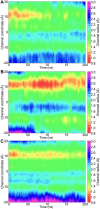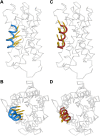Cooperativity in Plant Plasma Membrane Intrinsic Proteins (PIPs): Mechanism of Increased Water Transport in Maize PIP1 Channels in Hetero-tetramers
- PMID: 30104609
- PMCID: PMC6089885
- DOI: 10.1038/s41598-018-30257-4
Cooperativity in Plant Plasma Membrane Intrinsic Proteins (PIPs): Mechanism of Increased Water Transport in Maize PIP1 Channels in Hetero-tetramers
Abstract
Plant aquaporins (AQPs) play vital roles in several physiological processes. Plasma membrane intrinsic proteins (PIPs) belong to the subfamily of plant AQPs. They are further subdivided into two closely related subgroups PIP1s and PIP2s. While PIP2 members are efficient water channels, PIP1s from some plant species have been shown to be functionally inactive. Aquaporins form tetramers under physiological conditions. PIP2s can enhance the water transport of PIP1s when they form hetero-tetramers. However, the role of monomer-monomer interface and the significance of specific residues in enhancing the water permeation of PIP1s have not been investigated at atomic level. We have performed all-atom molecular dynamics (MD) simulations of homo-tetramers and four different hetero-tetramers containing ZmPIP1;2 and ZmPIP2;5 from Zea mays. ZmPIP1;2 in a tetramer assembly will have two interfaces, one formed by transmembrane segments TM4 and TM5 and the other formed by TM1 and TM2. We have analyzed channel radius profiles, water transport and potential of mean force profiles of ZmPIP1;2 monomers. Results of MD simulations clearly revealed the influence of TM4-TM5 interface in modulating the water transport of ZmPIP1;2. MD simulations indicate the importance of I93 residue from the TM2 segment of ZmPIP2;5 for the increased water transport in ZmPIP1;2.
Conflict of interest statement
The authors declare no competing interests.
Figures








Similar articles
-
A conserved cysteine residue is involved in disulfide bond formation between plant plasma membrane aquaporin monomers.Biochem J. 2012 Jul 1;445(1):101-11. doi: 10.1042/BJ20111704. Biochem J. 2012. PMID: 22506965
-
Interactions between plasma membrane aquaporins modulate their water channel activity.Plant Cell. 2004 Jan;16(1):215-28. doi: 10.1105/tpc.017194. Epub 2003 Dec 11. Plant Cell. 2004. PMID: 14671024 Free PMC article.
-
Maize plasma membrane aquaporins belonging to the PIP1 and PIP2 subgroups are in vivo phosphorylated.Plant Cell Physiol. 2008 Sep;49(9):1364-77. doi: 10.1093/pcp/pcn112. Epub 2008 Aug 4. Plant Cell Physiol. 2008. PMID: 18682426
-
Carbon dioxide and water transport through plant aquaporins.Plant Cell Environ. 2017 Jun;40(6):938-961. doi: 10.1111/pce.12844. Epub 2016 Dec 1. Plant Cell Environ. 2017. PMID: 27739588 Review.
-
PIP1 aquaporins: Intrinsic water channels or PIP2 aquaporin modulators?FEBS Lett. 2015 Nov 30;589(23):3508-15. doi: 10.1016/j.febslet.2015.10.018. Epub 2015 Oct 23. FEBS Lett. 2015. PMID: 26526614 Review.
Cited by
-
Differential regulation of drought stress by biological membrane transporters and channels.Plant Cell Rep. 2021 Aug;40(8):1565-1583. doi: 10.1007/s00299-021-02730-4. Epub 2021 Jun 16. Plant Cell Rep. 2021. PMID: 34132878 Review.
-
dbAQP-SNP: a database of missense single-nucleotide polymorphisms in human aquaporins.Database (Oxford). 2023 Mar 13;2023:baad012. doi: 10.1093/database/baad012. Database (Oxford). 2023. PMID: 36913438 Free PMC article.
-
The pip1s Quintuple Mutants Demonstrate the Essential Roles of PIP1s in the Plant Growth and Development of Arabidopsis.Int J Mol Sci. 2021 Feb 7;22(4):1669. doi: 10.3390/ijms22041669. Int J Mol Sci. 2021. PMID: 33562315 Free PMC article.
-
Aquaporins: More Than Functional Monomers in a Tetrameric Arrangement.Cells. 2018 Nov 11;7(11):209. doi: 10.3390/cells7110209. Cells. 2018. PMID: 30423856 Free PMC article. Review.
-
Is the E. coli Homolog of the Formate/Nitrite Transporter Family an Anion Channel? A Computational Study.Biophys J. 2020 Feb 25;118(4):846-860. doi: 10.1016/j.bpj.2019.12.024. Epub 2019 Dec 31. Biophys J. 2020. PMID: 31968229 Free PMC article.
References
Publication types
MeSH terms
Substances
LinkOut - more resources
Full Text Sources
Other Literature Sources

